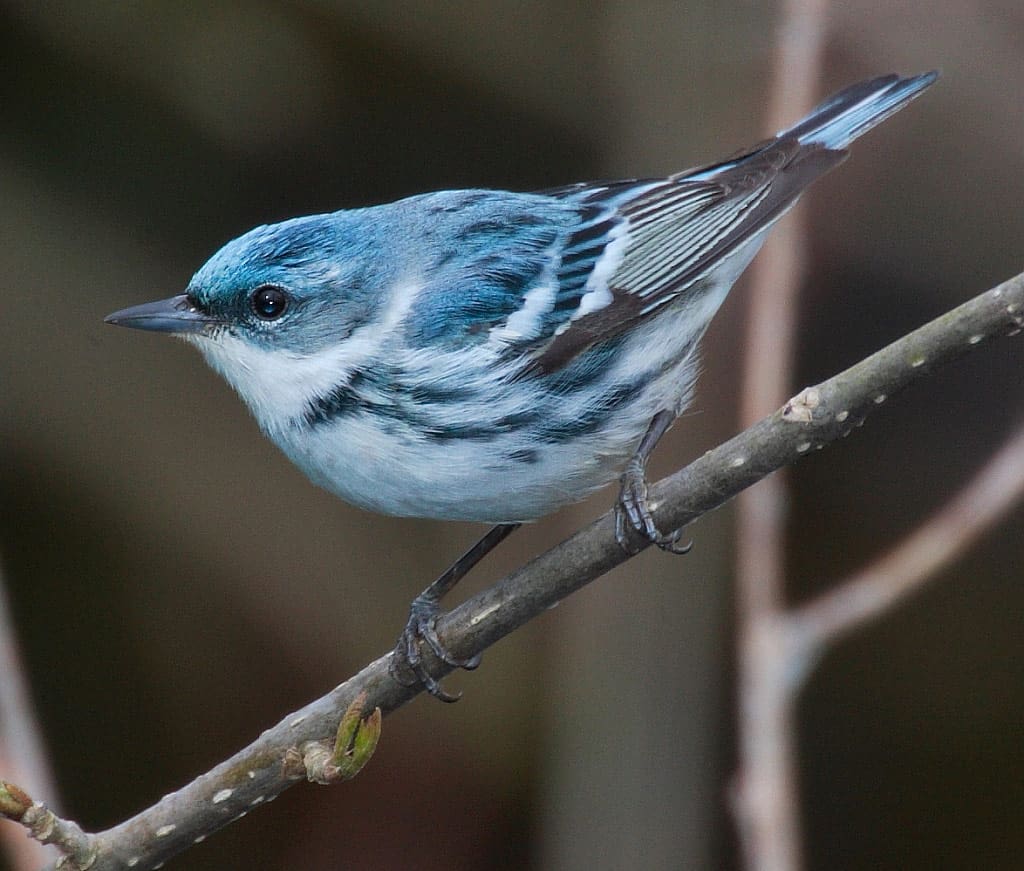1. Tundra Swan

The tundra swan is the only native swan found in Ohio, and could only be confused with the introduced mute and trumpeter swans. These swans are by far our largest waterfowl—tundras weigh 16 pounds—and can easily be confused from afar. Mute swans are separated by their orange bill and graceful curved-neck posture, with the bill held downward. Telling tundra from trumpeter is a bit trickier, but generally the tundra swan’s yellow lores, slightly smaller size, and more rounded head and bill profile separate the two. Tundra swans are the only species of swan likely to be encountered in migrant flocks.
Ohio sits in the path of their flight to and from the Arctic nesting grounds. On rare occasions, flocks numbering into the thousands have been encountered, but more typical are groups of 20 to 50 birds. Fall is the best time to find tundra swans, particularly during the peak movements from mid-November into December. They are harbingers of winter, tending to push ahead of cold fronts, and are often seen in the best numbers on cold, blustery days, the flocks blending with the first snowflakes of winter.
Most swans are seen along the shoreline of Lake Erie, and inland throughout the western half of Ohio, especially at the big wetland complexes of Killdeer Plains and Big Island wildlife areas. The best place, though–both spring and fall—are the western Lake Erie marshes, in the vicinity of Ottawa National Wildlife Refuge. Excellent spring flocks are always spotted, typically in March, at the massive wetlands found at Killbuck Marsh and Funk Bottoms wildife areas. Tundra swans are often heard before they are seen, as flocks emit loud, high-pitched and unmistakable reverberating oo-oo-whoo sounds—a sound of the wilderness.
2. Northern Bobwhite
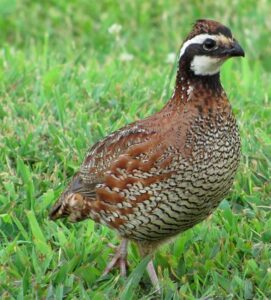
Photo by Brian Stansberry via Wiki Commons
The handsome northern bobwhite is Ohio’s only native quail. These small, chunky ground-dwellers weigh but seven ounces, but flush from underfoot with surprising velocity, appearing larger than they really are. The males have distinctive facial patterns, with a bright white throat and eye stripe. Females look nearly identical, but the white is replaced with muted brown tones.
Once abundant throughout Ohio, the northern bobwhite has experienced a boom and bust history. Their peak came in the mid-1930’s, when some ornithologists estimated that there were as many as 20 pairs to be found in every square mile of suitable habitat. After that, rapidly changing habitats caused a steady reduction in numbers, as the rural landscape and its farms became increasingly well manicured, and less bird-friendly. The final blow came with the severe winters of 1976-78, which decimated quail populations throughout the northern two-thirds of Ohio.
Today, the cheery, whistled bob-white! call is only likely to be heard in the southernmost counties, and even there it is best to know the reliable places to look. Generally, the counties that border the Ohio River are the most productive for quail-seekers; especially Adams, Brown, Gallia, Highland, Lawrence, and Meigs counties. A trip to the Crown City Wildlife Area is almost guaranteed to produce quail, and another excellent site is Woodbury Wildlife Area in Coshocton County. Here, an ongoing bobwhite reintroduction program has been successful, and birds are found throughout the area. Bobwhites are best found in spring and summer, when the males deliver their distinctive song – often from high in a tree!
3. Red-shouldered Hawk

Perhaps the most beautiful raptor found in Ohio, adult red-shouldered hawks are striking and unmistakable. The namesake red shoulder patch can be difficult to see except at close range, but the combination of large size, reddish barring underneath, broad black bars on the tail, and light and dark barring on the underwings should easily separate this species from all others. Red-shouldereds deliver a high-pitched series of loud notes; kee-ya, kee-ya – but don’t be fooled by the blue jay, which can imitate them to perfection.
Because of their preference for woodland habitat red-shouldereds are not nearly as common, and are more inconspicuous and harder to find than red-tails. With the massive land clearing that resulted with the settlement of Ohio, red-tailed hawks became more common, and red-shouldered hawks declined precipitously in many areas. Fortunately, Ohio’s forests are recovering, and red-shouldered hawk populations are on the upswing, and they have begun to colonize areas that they haven’t occupied for decades.
It takes a watchful eye, but it isn’t too tough to find red-shouldered hawks year-round throughout the forested regions of southern and eastern Ohio. They are common in the Hocking Hills region, and a pair is usually found near the entrance to Conkle’s Hollow State Nature Preserve. You may also catch red-shouldereds in migration. Some of the best places do catch these flights are the “hawk tower” by the parking lot at the Magee Marsh Wildlife Area visitor’s center, and “the hill” near the lodge at Maumee Bay State Park. March is the time, and if the winds are favorable – strong and from the south – more than a hundred birds might be seen winging westward along Lake Erie, with peak passages generally occurring between 10 am and 3 pm.
4. Rough-legged Hawk
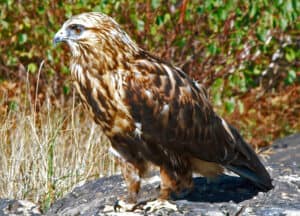
These magnificent raptors are strictly winter visitors in Ohio, moving into our region from their high-arctic nesting grounds. There are two behavioral traits that rough-legged hawks often display, that aid in long distance identification. One of these is their habit of perching at the very tip of trees, kind of like a feathered Christmas tree ornament. The other distinctive habit is known as “wind hovering”, a hunting method in which the bird, facing into the wind, hovers in one spot as it sizes up potential prey. Rough-legged hawks are also distinctive among our raptors in that they display two color phases, or morphs. The most commonly encountered is the light morph, which outnumber dark birds by about 10 to one. Light birds have a distinctive dark belly band, dark wrist patches under the wings, and a whitish tail with a broad blackish terminal band. Dark phase birds look mostly black except for whitish underwings and tail base.
Like many other northern predators, rough-legged hawks are cyclically irruptive, meaning that more birds move farther south some years than others. These irruptions are directly tied to the availability of food, primarily lemmings (a small mammal). In years of lemming shortages, we get more of these raptors in Ohio. Rough-legged hawks are birds of wide-open country. Many times, rough-legs can be closely approached and display little fear of people.
One of the best places to find rough-legged hawks are the massive reclaimed strip mines of southeastern Ohio. In a good winter, as many as several dozen rough-legs might be seen in a place like The Wilds. This species also turns up in excellent numbers in the historic prairie regions of Ohio, particularly at Big Island and Killdeer Plains wildlife areas.
5. Great Black-backed Gull
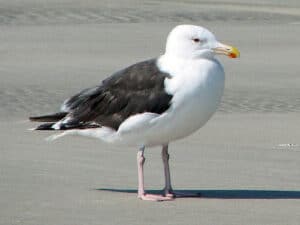
Amongst the throngs of gulls that queue up in favored Lake Erie locales, the adults of this species stick out a sore thumb. Great black-backed gulls are the largest gull species in North America, and the biggest can weigh 3-1/2 pounds. This massiveness, coupled with the black mantle (upper wing and back) coloration, renders adults unmistakable. Even subadult great black-backed gulls are pretty straightforward identifications, with their huge size, very large bill, and powerful dimensions.
Of all the states, Ohio is one of the best places to be for the avid gull-watcher. An amazing 19 species have been recorded here, and this gull bounty can be attributed directly to the presence of Lake Erie. While gulls have become much more common inland in recent years, virtually all the gulls seen away from Lake Erie are ring-billed gulls, with an occasional herring gull thrown in. However, Lake Erie attracts several species that are almost never found elsewhere in Ohio, and the great black-backed gull is the most obvious and easily found of these.
At favored winter locales, such as off the Cleveland lakefront, groups numbering into the hundreds can be found. Observation of this species is easiest in cold winters, when the waters of Lake Erie freeze solid. Under those conditions, gulls congregate around power plants that discharge warm water into the lake, creating large openings in the ice. Places like Cleveland Lakefront State Park at East 72nd Street or the power plant at Avon Lake make for great study of these interesting birds. In winter, great black-backeds are often associated with unusual gulls such as Iceland, glaucous, Thayer’s, and lesser black-backed gulls.
6. Pileated Woodpecker
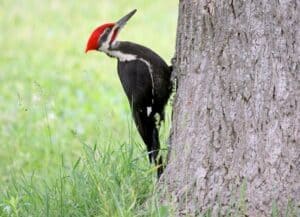
The inspiration for well-known cartoon character Woody Woodpecker, the pileated woodpecker is the sixth largest woodpecker in the world, and is the size of an American crow. They are unmistakable, but surprisingly secretive and hard to view. Becoming familiar with their calls, which are quite loud and sound a bit like deranged laughter, is the best way to find them. Pileated woodpeckers make very distinctive cavities, too, leaving evidence of their presence. Nest cavities are quite large, and are oval in shape. This species is especially fond of carpenter ants, and is very adept at locating them in infested trees. When they do, pileateds attack the tree with their huge, powerful bills, and leave a pile of very large wood chips at the base of the tree.
At the time of European settlement, pileated woodpeckers were no doubt plentiful. As forests were gradually cleared to make way for people, forest-dwelling birds like this woodpecker declined, and reached their nadir in the early 1900’s, when forest cover was at an all-time low. Today, much of our forests have regenerated and about one-third of the state is in forest cover. Pileated woodpeckers are common through much of Ohio. The do require a larger territory than our other woodpeckers – about 100 acres of woods – so they are rare in the heavily agricultural regions of western Ohio.
The best place to find pileated woodpeckers are the large forests of southern and eastern Ohio. Almost all of the state forests have plenty, and it won’t take very long to find pileateds by driving the roads that traverse the 63,000 acres of Shawnee State Forest. Many urban metroparks harbor pileated woodpeckers if forest cover is adequate. This woodpecker is non-migratory and a year-round resident, and winter is perhaps the best time to find them.
7. Carolina Wren

The cheerful, loud, ringing song of the Carolina wren is delivered year-round, and can now be heard in all quarters of Ohio. Of the five species of wrens that occur regularly, this is the only one that is common and widespread in winter. It is also the largest and most brightly colored of our wrens. This species is often attracted to the trappings of humans, and frequently occurs around yards, farms, and parks. They build their bulky twig nests in shady recesses, and have a penchant for choosing odd sites, such as hanging flower pots, discarded gloves, old drain pipes – even the glove compartments of old cars!
Carolina wrens were not always common; this species has had a checkered history in our state. Before Europeans arrived and began to settle Ohio, they were probably not present. As the forest primeval was opened up, conditions became better for this little bird of woodland openings and edges. With time, Carolina wrens steadily expanded northward until they had conquered most of Ohio. As with most species that have rapidly expanded northward at this latitude, Carolina wrens are very vulnerable to severe winters, which can greatly reduce their numbers. The savage winter of 1977–78 caused an estimated 90% decline in the population, and they are probably still on the rebound, being the scarcest in the northern third of the state.
A visit to almost any woodland or suburban neighborhood should produce Carolina wrens, especially the farther south one goes in Ohio. Bird feeders often attract these wrens, particularly in the colder months. As Carolina wrens are very loud, persistent singers, they are one of the more conspicuous birds in the forest. Like other wrens, they are quite inquisitive and readily lured into close proximity by pishing or making squeaking sounds.
8. Hooded Warbler
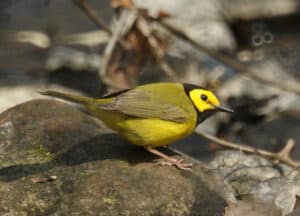
This is a bird much more likely to be heard than seen, though with a decent view, the male hooded warbler is unmistakable. Females are less distinctive, but are identifiable by their unmarked lemon yellow underparts, greenish back, and the faint trace of the male’s dark cap. The huge eye is a good character, too – this species has the largest eye of any of our warblers, and adaptation to their shady habitat.
As Ohio’s forests have recovered and matured in recent decades, hooded warbler populations have increased. This is a bird of dense forest understory – the shrub layer that lies under the tall crowns of mature trees. They are least common in the agricultural country of western Ohio, where larger woodlands are few and far between. In the large forests of southern and eastern Ohio, hooded warblers are generally plentiful, but a new threat is on the horizon. The proliferation of non-native invasive shrubs that have escaped and are multiplying in the wild does not bode well for the hooded warbler. The non-natives – such as bush honeysuckles – do not provide as viable a habitat as do native shrubs like spicebush and viburnum, and their continued spread may reduce populations of this colorful warbler.
Hooded warblers are easily found in large woodlands, and at a place like Mohican State Forest or Clear Creek Metropark it is possible to tally multiple singing males in a morning. And knowing the clear ringing song is essential to their detection, as they are real skulkers, and by recognizing the song, it is possible to search and eventually find the singer.
9. Cerulean Warbler
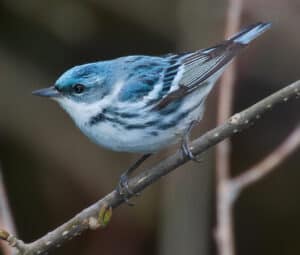
This feathered sprite is one of our most beautiful birds, and is also thought to be experiencing one of the most rapid population declines of any of the warblers. A true transglobal wanderer, the bulk of the remaining cerulean warbler populations are in Ohio and West Virginia, but the species winters primarily in Columbia and Venezuela. Reasons for the decline are unclear. Some scientists think that habitat loss – on both the breeding and wintering grounds – could be adversely impacting this warbler. Because of its showy appearance and conservation concern, the Ohio Ornithological Society selected the cerulean warbler for its logo.
Cerulean warblers were undoubtedly far more numerous in pre-settlement Ohio than they are today. As our forests fell before the axes of settlers, much cerulean warbler habitat disappeared as well, and today large swaths of Ohio no longer support habitat for this species. In Ohio, the principle habitat is large tracts of upland oak-hickory forest, and they occur in greatest numbers where the forest canopy is uneven due to various age classes of trees in close proximity. Thus, modern logging practices which often produce large-scale, even-aged timber stands probably has negative effects on cerulean warblers.
Ohio is one of the best places to find cerulean warblers, and they’re not tough to find in the right places. The dry oak-hickory dominated ridge tops of unglaciated southeastern Ohio support the best populations. Just be sure to become acquainted with its buzzy, ascending song, as cerulean warblers rarely leave the upper canopy of the forest, and require a bit of effort to see. Shawnee State Forest probably has the largest population, and an intrepid birder might tally a few dozen there in a day. All of the forested state parks in the Hocking Hills region are good places, as is nearby Clear Creek Metropark.
10. Henslow’s Sparrow

The inconspicuous Henslow’s sparrow was first discovered right across the Ohio River from Cincinnati, Ohio – John James Audubon shot the first specimen in 1820 in Kentucky. This drab sparrow is thought to be one of the rarest sparrows in the eastern U.S., but it is often overlooked. Possessed of one of the bird world’s most undistinguished songs, the male Henslow’s makes a sound that is more reminiscent of an anemic cricket than a bird, and this “song” lasts but 2/3rds of a second. Henslow’s sparrows are rather handsome, with an odd, chunky, big-headed appearance, subtle striping, and an olive-colored head.
There is no question that Henslow’s sparrow populations have decreased in Ohio. In the early to mid 1900’s, there were many more bird-friendly farms scattered throughout the state. These farms had lots of fallow fields, hay meadows and unkempt pastures, which are good Henslow’s sparrow habitat. Gradual changes in agricultural practices have largely eliminated Henslow’s sparrows from many of its former locales. Today, by far the largest populations are found in a relatively new Ohio habitat – reclaimed strip mine grasslands. These massive grasslands came into being beginning in the mid-1970’s, when laws were enacted requiring mining companies to reclaim mine sites, and plant them to grass.
Be warned – to effectively seek Henslow’s sparrows, one must become familiar with its unbirdlike, somewhat ventriloqual song. Compounding detection difficulties, the males often sing from a perch largely hidden within the vegetation. On the plus side, Henslow’s sparrows are persistent singers and are often loosely colonial, so where there’s one, there will be several. By far the best places to seek this fascinating grassland dweller are the reclaimed strip mines of southeastern Ohio. Some of the best places to look include The Wilds, and Crown City, Egypt Valley, Tri-Valley, and Woodbury wildlife areas.

